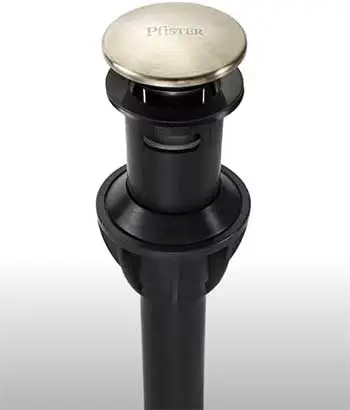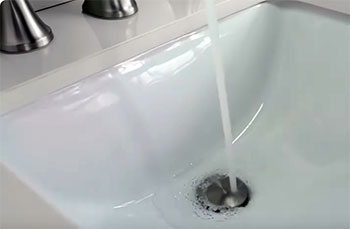The Pfister push and seal drain is a great option for a drain assembly. It provides great results for your drain assembly and makes things very much convenient. Also, it’s easy to install and use as well.
However, you will come across customers saying Pfister push and seal drain leaking whenever you research a bit. Why does that happen? And how can you fix it?
That’s what I will be talking about here today.
Why Is The Pfister Drain Leaking?

While the drain assembly works great and gives you a lot of benefits, the leaking issue can be pretty annoying. There are several reasons for this issue to happen in your Pfister drain system.
So, it’s essential to know about them before you can even try solving them. Let’s get ahead and see what causes the leaking problem.
- Improper Installation
The most common reason that can cause the drain to leak is improper installation. If you messed up on the installation process or didn’t follow the proper installation method, you will surely end up with leaks around the drain assembly.
While the whole thing isn’t difficult to install, there is a particular technique that you have to follow for the proper installation. Whenever you miss out on a step, the drain assembly starts leaking at some point.
- When Your Sink Has Little Pits
Sometimes, it’s not even the drain system that’s the problem; it can be your sink. If your sink has lots of little bits here and there, you will have leaking issues at some point for sure.
When one of those leaks comes in contact with the seal and bottom of the sink, it causes a leaking problem around the drain.
This is pretty evident as you get to see your drain leaking from the seal. The leaking happens slowly on the threads of the washer and nut.
- Damaged Seal
A damaged seal is a pretty common issue for leaking, no matter where it is applied. Now, this isn’t something that you have to worry about if you have installed the drain system recently.
But if it has been a while, then it can be an issue that you have to consider.
Because over time, the seal may wear out with rough usage. And it’s just something you can’t avoid at times. Also, external damages can impact the seal at times, so you have to count that factor in.
Typically, these are the reasons that can cause a leakage in your drain system with the Pfister push and seal system. Now, let’s get through the solutions that you can try out to avoid any leaking problems with this thing.
How To Fix The Pfister Push And Seal System From Leaking?
The good news is that you can find very easy fixes to this problem. And most of the time, you don’t even need to do anything special to get the job done.
All you do is follow some procedure, and you are good. Enough chattering, let’s get ahead with the solutions now –
- Follow The Proper Installation Method

The first thing to ensure is that you have installed the system properly.
To do that, you can just follow the instructions they provide in the system’s packaging.
You can also try out different installation guides or tutorials on the internet and follow that along.
Another thing you can try is to use the proper sealing method.
You can see just silicone under the gasket system and then around the drain body for the appropriate sealing method.
This will provide better sealing on the drain system. Make sure to crank it down to get the best possible results.
You must ensure that you are tightening it properly while installing the drain system. Most of the time, it’s just the loose threading that results in leakage issues around the threads.
And the only solution to that problem is to tighten it correctly. Hand tightening should be enough, but you can use wrenches or pliers if you don’t want to struggle.
Also, before you go ahead and try installing this on your sink, you have to check whether your sink has overflowed or not. Because this system doesn’t work on a sink without an overflow.
So, if you install this on a sink without an overflow, you just end up leaking.
- Fixing The Issues With Little Pits
With the situation of little pits on the sink, you can try out another sealing method. So, whenever you face leakage around the sealing washer or the nut, you can opt for this solution.
Here’s what you have to do –
You can liberally apply some silicone caulk around the threading of the drain system. You have to use the caulk on the exact place where the rubber seal contacts the whole thing.
Also, try using some on the sealing surface to ensure you don’t have any kind of leaking whatsoever.
The thing with this is that you can do all this by yourself. You don’t need any prior experience to fix this issue. However, you can still call in a professional plumber if you want to get the best possible solution.
- Fixing The Damaged Seal
Well, the solution to this problem is very obvious. You just have to replace the damaged seal with a new one.
The thing with this fix is that you will need to find a proper sealant for the job, and you will have to install it all over again.
Also, when you install a new seal, make sure you are tightening it all the way. Without tightening the seal properly, you just end up with the same problem.
So, make sure you have installed the seal perfectly.
As you can tell, the solutions don’t require too much work. Also, you can avoid the leaking issue in the first place with proper installation. All you have to do is make sure you have tightened the sealing.
Lastly, I want you to watch the official installation video.
Are The Pfister Push And Seal System Still Worth It?
Even with this common leaking issue, I would say the system is still worthwhile. It comes with so many handy features that you will love to experience the whole thing.
And it’s surely a value for money option.
And if you are worried about the leakage problem, then I have to say, it’s not something that you will face for sure. If you are making sure you have installed the system properly and using the correct sealing process, you don’t need to worry about anything else.
Altogether, the system delivers on its promises, and that’s the part you should be focusing on more than anything else.
Push and Seal Drain Leak Troubleshooting Tips
Here are some additional pointers for diagnosing the source of any leaks in a Pfister push and seal drain:

- Check below the sink first whenever a leak occurs to pinpoint the source.
- Leaks from the threaded drain body mean the seal at the sink needs redoing.
- Leaks from the outer holes or bottom edge indicate a bad gasket.
- Leaks from the push button point to a defective internal seal.
- If water only leaks while actively draining, suspect a bad rubber gasket.
- If leaks occur with the button in both up and down positions, the body seal is likely compromised.
- Examine the condition of the rubber gasket closely to check for cracks or damage.
- Test the button motion by hand to ensure it springs back fully when released.
- Confirm the retaining nut is tightened adequately but not overtightened.
- Try wiping plumber’s putty around the drain hole to temporarily stop any body leaks as a test.
By methodically examining where the water comes from and when, you can isolate whether the gasket, button, or drain body seal is the culprit.
FAQs
A pop-up drain stopper can leak for a few common reasons:
Worn out drain seal – The rubber seal between the stopper and drain gets cracked or compressed over time, allowing water to leak past. Replacing this seal usually fixes the leak.
Debris buildup – Hair and gunk under the stopper can prevent it from sealing fully. Cleaning the drain thoroughly often helps.
Loose stopper nut – The nut securing the stopper assembly can loosen over time, causing the stopper to fit improperly and leak. Tightening the nut may stop the leaking.
Damaged control rod – If the rod connecting the stopper to the pop-up lever is bent or broken, it can affect sealing and cause leaks.
1. Remove the stopper and basket strainer. Inspect under for built up gunk.
2. Use a small brush and mild cleaner to scrub the drain body, push button mechanism, and rubber gasket.
3. Flush with hot water. Make sure the push button moves smoothly.
4. Check the gasket for cracks. Replace if worn out.
1. Check under the faucet handle for any loose connections or worn washers/seals. Tighten or replace as needed.
2. For leaks at the spout, inspect the cartridge or faucet aerator. Clean or replace if worn.
3. For leaks at the base, ensure the faucet is sealed properly to the sink. Reapply plumber’s putty if needed.
4. Dripping from the spout when shut off indicates worn faucet washers or cartridge valves. Replace any defective internal parts.
Some potential causes of a leaky drain flange:
Deteriorated plumber’s putty – The putty around the flange creates the water tight seal. If cracked or flawed, water can leak past.
Corrosion – Rust or mineral deposits on the flange can prevent a tight seal. Cleaning or replacing may be required.
Cracked/damaged flange – If the flange itself is warped or split it may not seal correctly.
Improper installation – If the flange is not aligned, leveled, and tightened properly, leaks can develop.
Drain pipe issues – A damaged or misaligned tailpiece/drain pipe can affect flange sealing and cause leaks.
Conclusion
Summing it up, the Pfister push and seal drain leaking can be annoying for sure, but it’s not the end of the world. You can find some easy fixes that don’t require too much effort or cost to get the job done.
Considering that, I would say it’s a great option for a push and seal drain system.
Now, coming to the installation part, you can do it by yourself for the most part. But if you don’t want to take any risks or aren’t confident in the process, then I recommend hiring a professional to install it.
